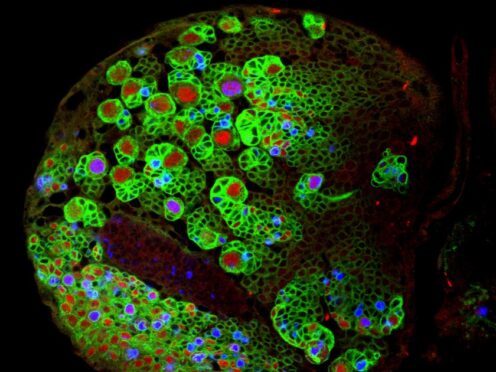
Scientists believe fruit flies could help them stop the growth of brain tumours.
Experts at the Brain Tumour Research Centre of Excellence at the University of Plymouth have been able to identify and examine cells at the very first stages of growth by using the fruit fly Drosophila as a model.
Their work is helping further the understanding of glioma tumours, which include high-grade types such as glioblastoma.
Glioblastoma has a poor survival rate and tumours grow quickly, invading and destroying healthy tissue.

They can happen at any age but tend to occur more often in older adults.
Symptoms include headaches that keep getting worse, nausea and vomiting, blurred or double vision, and seizures.
Dr Claudia Barros, who led new research published in EMBO Reports, said her team had uncovered “readying” processes which could be vital for helping tumours form and grow.
She said: “The research contributes to understanding of how brain tumours could form and has opened up avenues of research to find new potential drug targets towards novel therapies for patients with glioma tumours.
“Using the fruit fly Drosophila as a model, we have been able to identify and examine cells at the very initial stages of brain tumour formation inside the brain.
“These cells have most striking differences in their metabolic and protein balance landscape compared to normal cells.”

Dr Karen Noble, director of research, policy and innovation at the Brain Tumour Research charity, said: “There is much work still to be done, but these early findings are significant because, with more investigation, it could help us develop new treatments which will target tumour cells more effectively and so improve outcomes for patients.”
Sam Suriakumar, a self-employed recruitment consultant and part-time musician from south-west London, was diagnosed with a low-grade glioma after suffering seizures.
The 38-year-old’s tumour was being monitored but a scan last July showed it had grown.
He is now undergoing chemotherapy, having already had surgery and radiotherapy.

The father-of-two said: “It’s amazing to think that something as little as a fruit fly could help improve our understanding of tumours like mine and how best to treat them.
“It’s really exciting news and serves as an important reminder of the need for greater investment in research to help get us to our goal of finding a cure sooner.”

Enjoy the convenience of having The Sunday Post delivered as a digital ePaper straight to your smartphone, tablet or computer.
Subscribe for only £5.49 a month and enjoy all the benefits of the printed paper as a digital replica.
Subscribe